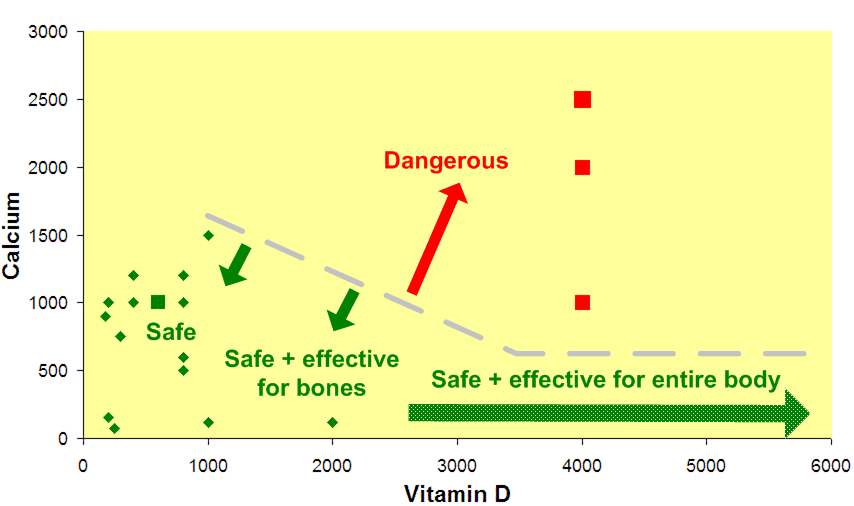Controversy: Too much Calcium if increase Vitamin D
50 percent of elderly got hypercalcimia with 2000 IU of vitamin D – Feb 2011
Evaluation of the effectiveness of cholecalciferol in long-term care elderly patients with hypovitaminosis d.
Consult Pharm. 2011 Feb;26(2):101-7.
Shin M, Minden C.
Sullivan University College of Pharmacy, Louisville, Kentucky.
Objective: To study the efficacy and safety of cholecalciferol (vitamin D3) 2,000 units daily for 12 weeks in elderly patients with hypovitaminosis D. Secondarily, to postulate causes for those patients who did not return to normal 25-hydroxy vitamin D (25-OHD) levels.Design: One-group, pretest post-test. Retrospective chart review. Data collected from Computerized Patient Record System.Setting: Long-term care facility at Central Arkansas Veterans Healthcare System.Patients, Participants: Potential study subjects were elderly patients (? 65 years of age) treated with total daily dose of cholecalciferol 2,000 units daily by mouth, for at least 12 weeks' duration period between July 1, 2007, and July 31, 2009, with documented 25-OHD levels before and after treatment.Interventions: None.Main Outcome Measures: Efficacy of cholecalciferol was assessed by categorizing patients as responders (25-OHD levels ? 30 ng/mL) and nonresponders (25-OHD levels < 30 ng/mL).
Safety of vitamin D3 was determined by measuring prevalence of hypercalcemia. Patient demographics, disease states, and medications that can affect 25-OHD levels between responders and nonresponders of vitamin D treatment were assessed.
Results: 24 patients were included in analysis. 58.3% (14) of patients responded to cholecalciferol treatment and 41.7% (10) of patients did not. The mean 25-OHD level after treatment was 38.7 ng/mL in responders and 26.4 ng/mL in non responders.
Twelve patients (50%) developed hypercalcemia.
Conclusion: The present study has shown that some long-term care elderly patients respond to three months of vitamin D supplementation.
The reason why some patients did not respond cannot be determined from this study. PMID: 21310707
Chart from Overview of IoM

See also Vitamin D Life: controversy
No risk of hypercalcemia with prolonged 10,000 IU of vitamin D3 – July 2010
Yet again, 1 gram of Calcium increases Kidney stones with vitamin D – July 2011
10,000 IU vitamin D plus 1200 mg Calcium MS trial - April 2010
Increasing vitamin D does not continue to increase Calcium – July 2010
Calcium level somewhat higher due to vitamin D might be a problem – June 2010
More Calcium absorbed with more vitamin D – 6.7% more with 4000 IU – RCT March 2014
Increased Vitamin K2 reduces the problems of excess Calcium – Nov 2013
Osteoporosis Canada Sept 2010 Upper limit as high as 10,000 IU daily
